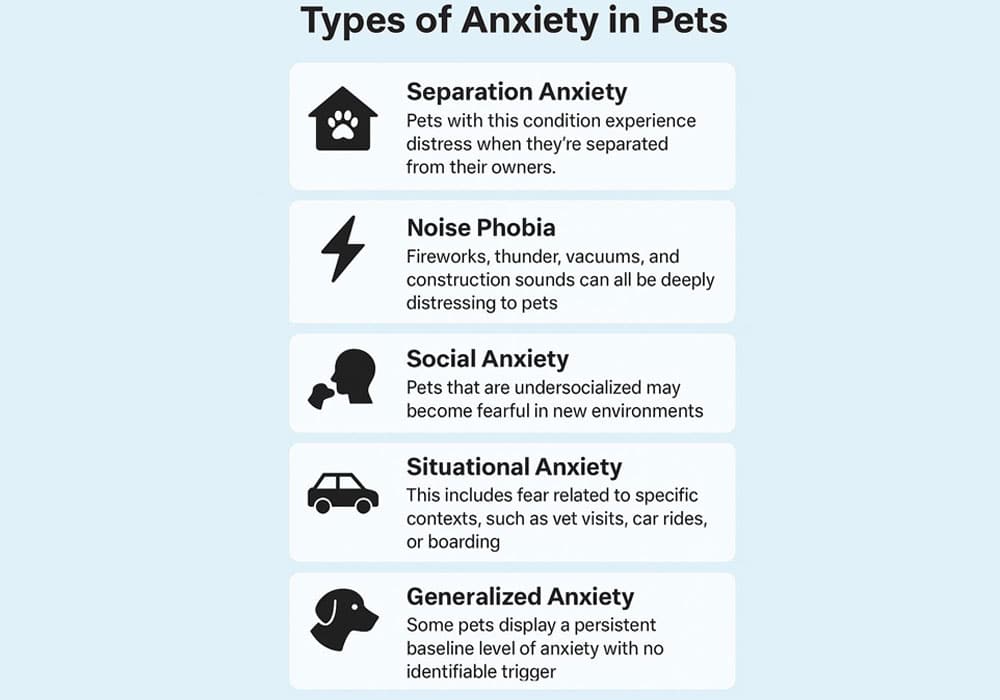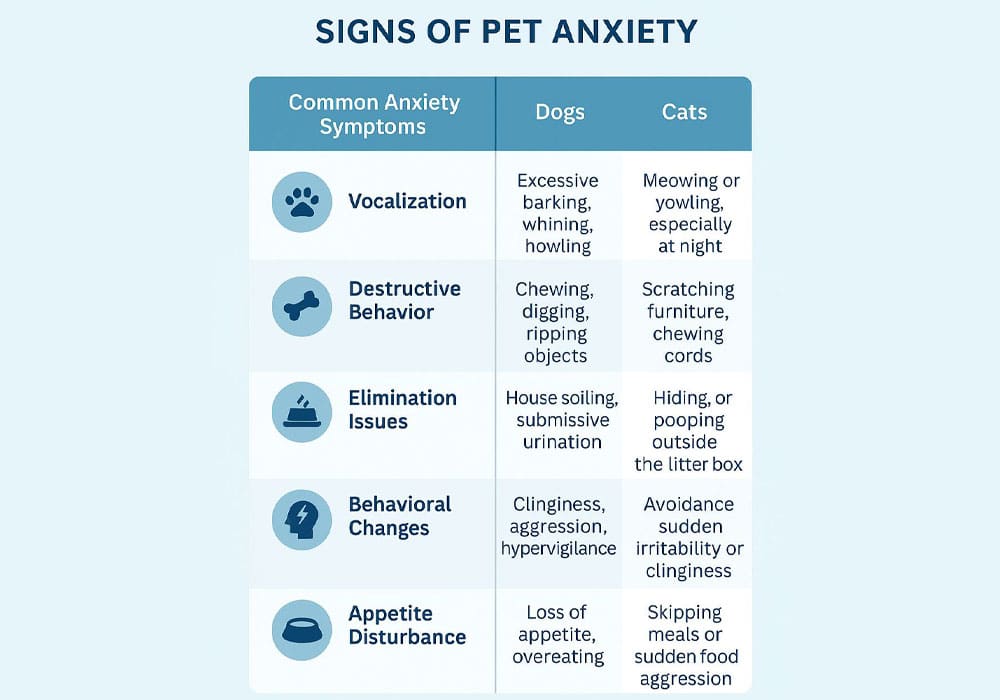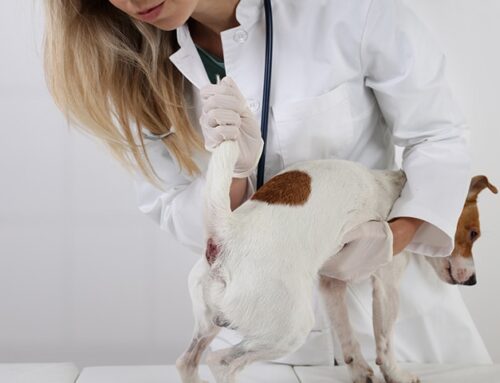Understanding Pet Anxiety: Symptoms, Causes, and How Vets Help
Top 3 Takeaways – Pet Anxiety
What Is Pet Anxiety?
Anxiety isn’t just a human experience—it’s something our pets can suffer from too. Whether your dog starts trembling at the sound of fireworks or your cat disappears for hours during a house party, these behaviors could be signs of something deeper. Pet anxiety is a serious but often overlooked condition that can have a major impact on your pet’s physical and emotional well-being. Unlike a passing mood, untreated anxiety can worsen over time, leading to chronic stress, behavioral issues, and even health problems.
At Bliss Animal Hospital in South Orange County, CA, we know how heartbreaking it is to see your pet struggle. That’s why our team takes a comprehensive, compassionate approach to diagnosing and managing anxiety in both dogs and cats. This blog will help you understand what pet anxiety looks like, why it happens, and how veterinary care can dramatically improve your pet’s quality of life. Whether you’re dealing with mild unease or severe panic behaviors, you’re not alone—and help is available.
Types of Anxiety in Pets
Different types of anxiety require different approaches to treatment. That’s why it’s important to identify not just the presence of anxiety but also the specific category it falls into. Here are the most common types we encounter at Bliss Animal Hospital:
By narrowing down which category (or categories) apply to your pet, we can begin to build a plan that addresses the root of the problem—not just the symptoms.

Figure 1: Infographic: Five Common Types of Anxiety in Pets.
Common Causes of Pet Anxiety
To effectively treat anxiety, it’s critical to understand why it developed in the first place. Anxiety doesn’t usually come out of nowhere. It’s often linked to a mix of experiences, genetics, and environmental influences. At Bliss Animal Hospital, our team evaluates each pet’s unique background and daily life to identify potential contributors.
Root Causes to Consider
Pinpointing what’s driving your pet’s anxiety is key to finding lasting relief. Our team uses detailed history-taking and gentle behavioral evaluation to uncover the likely causes and tailor a plan accordingly.
Symptoms of Anxiety in Dogs and Cats
Anxious pets don’t always “look” anxious in obvious ways. What might seem like misbehavior or defiance could actually be a sign of chronic stress. That’s why it’s important to recognize the subtle and not-so-subtle clues that your pet may be struggling emotionally.
Behavioral issues related to anxiety can overlap with other conditions, so we always recommend a full veterinary evaluation to rule out pain, illness, or environmental stressors. Below is an expanded breakdown of typical anxiety symptoms in dogs and cats:
| Common Anxiety Symptoms | Dogs | Cats |
|---|---|---|
| Vocalization | Excessive barking, whining, howling | Meowing or yowling, especially at night |
| Destructive Behavior | Chewing, digging, ripping objects | Scratching furniture, chewing cords |
| Elimination Issues | House soiling, submissive urination | Peeing or pooping outside the litter box |
| Physical Signs | Panting, drooling, pacing, trembling | Hiding, excessive grooming, vomiting |
| Behavioral Changes | Clinginess, aggression, hypervigilance | Avoidance, sudden irritability or clinginess |
| Appetite Disturbance | Loss of appetite, overeating | Skipping meals or sudden food aggression |
If you’re observing one or more of these behaviors frequently or predictably—especially during known triggers—it’s time to consult a veterinarian.

Figure 2: Infographic: Common Signs of Anxiety in Dogs and Cats, Presented by Bliss Animal Hospital
Diagnosing Pet Anxiety: Why a Veterinary Exam Matters
While many pet owners can identify anxiety-like behavior, it’s important to work with a veterinarian to confirm the diagnosis. Medical conditions, chronic pain, vision or hearing loss, and even cognitive dysfunction in older pets can mimic anxiety. Treating anxiety without ruling out these possibilities could lead to ineffective or even harmful outcomes.
At Bliss Animal Hospital, our diagnosis process is designed to be thorough but fear-free. We prioritize your pet’s comfort while collecting the information we need to recommend the right path forward.
What to Expect During a Veterinary Anxiety Evaluation
Once we’ve established a diagnosis, we work with you to develop a personalized treatment plan focused on both short-term relief and long-term well-being.
How Veterinarians Treat Pet Anxiety
Veterinary treatment for anxiety goes far beyond prescribing a pill. The most successful outcomes involve a layered approach that addresses both the brain chemistry behind anxiety and the behavioral patterns that reinforce it. At Bliss Animal Hospital, we take a progressive, evidence-based approach to treating anxious pets.
Environmental and Behavioral Interventions
Many cases of mild to moderate anxiety can be improved through thoughtful changes to the pet’s daily life. We may recommend:
Medications for Moderate to Severe Anxiety
When behavior modification alone isn’t enough, medical therapy can make a world of difference. We tailor prescriptions to your pet’s needs, using medications that are safe and well-tolerated:
All treatment decisions are made with your input, and we carefully monitor for side effects and efficacy.
Conclusion
Pet anxiety is real, and you don’t have to manage it alone. With the right support and a tailored plan, your pet can live a much more peaceful and balanced life. Whether your dog panics during thunderstorms or your cat hides at every loud noise, there are solutions—and Bliss Animal Hospital is here to help.
Call to Action
Schedule online or call us at (949) 354-5201 to book your appointment today.
Veterinarian Near You in Orange County, CA
Managing pet anxiety takes compassionate care, personalized strategies, and a trusted veterinary team. At Bliss Animal Hospital, we support families across South Orange County with expert evaluations and tailored treatment plans for anxious dogs and cats. Whether you’re dealing with separation anxiety, noise phobias, or general nervous behaviors, our team is here to help.
Explore our anxiety-aware veterinary care near you:
Note: All services are provided at our Lake Forest location, conveniently located to serve all of South Orange County.
Meet Our Team
The blissfull faces behind the care
Driven by compassion and purpose, here is the team who will work to make a difference in your pet’s life. Every single visit.


What your neighbors are saying!
Areas we Serve at Bliss Animal Hospital:
“Better Care. Better medicine.” This is our motto, and our veterinary staff stands behind it.
Bliss Animal Hospital is conveniently located at the Home Depot Plaza in Foothill Ranch, less than a 10-minute drive from the neighborhoods of Lake Forest, Rancho Santa Margarita, Mission Viejo, and Irvine (Great Park and Portola Springs). We also serve more distant regions like Tustin, Coto de Caza, Las Flores, Ladera Ranch, Laguna Hills, Laguna Woods, Stonegate (Irvine), Woodbury (Irvine), and Cypress Village (Irvine).
Our vet hospital is ready to serve not only the communities of South Orange County but also anyone who truly believes that veterinary medicine starts with relationships.









Leave A Comment